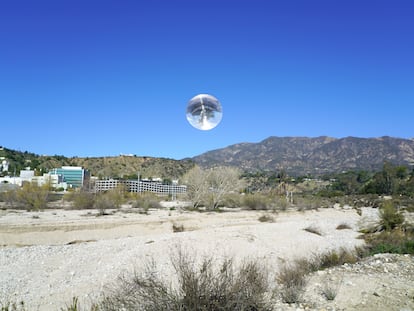For the first time, Prado Museum brings together eight works by El Greco from around the world
‘The Assumption of the Virgin’ – which belongs to the Art Institute of Chicago – was last displayed in the Madrid art gallery more than a century ago
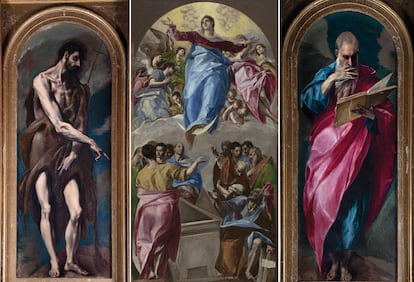
Upon entering the central gallery of the Prado Museum, visitors are greeted by El Greco’s The Assumption of the Virgin. It’s a monumental painting, which still looks fresh (with a bit of imagination, you can even smell the brushstrokes). When you stand in front of it, you need to strain your neck to observe the several feet of paint that depict the ascension of Mary into heaven, without any Evangelical references.
With a little more imagination, one can almost picture the great Greek painter in Toledo, shortly after arriving in Spain in 1577, thinking about how he would carry out one of his first major commissions: three altarpieces for the Monastery of Santo Domingo el Antiguo.
Eight of the nine pieces that the artist made for the monastery can now be seen until June 15. They’ve been brought together for the first time at the Madrid art gallery, in an exhibition titled El Greco: Santo Domingo el Antiguo.
The journey to the Prado begins in June of 1577, when there’s documentary evidence of the first time that Doménikos Theotokópoulos ― better known by his nickname “El Greco” ― showed up in Spain. Although he failed to attain royal patronage, that same year, the artist received a commission from Diego de Castilla, the dean of the cathedral. His son had informed him that this painter who hailed from the island of Crete had been training in Italy for some time, and could bring the best of the Renaissance to Toledo. This was the only reference that Don Diego had: up to that moment, El Greco’s CV didn’t have any Spanish experience.
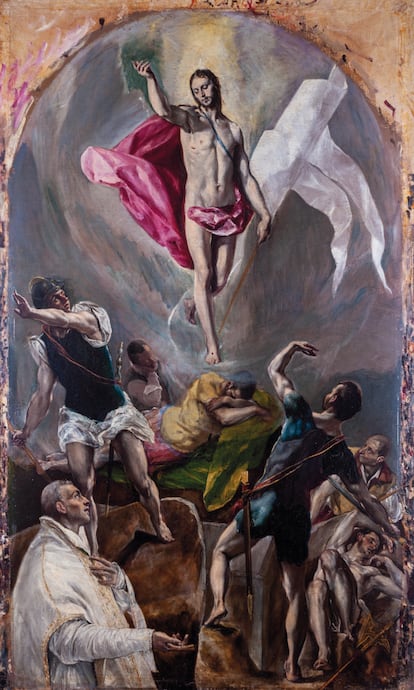
In two years, the painter would shake up the concept of the altarpiece that had spread throughout the churches, drawing on his knowledge of artists such as Titian and Dürer to enrich the Spanish tradition. “He had the ambition to change the reticular idea that prevailed in [the Kingdom of] Castile and propose a Venetian-style one instead,” explains Leticia Ruiz, curator of the exhibition and head of the Prado Museum’s collection of Spanish Renaissance painting. “He placed The Assumption in the center: the rest of the pieces [appear to be] awaiting the central canvas.” This refers to the four saints on the sidelines – Saint John the Baptist, Saint John the Evangelist, Saint Bernard and Saint Benedict – and, in the upper section, the Holy Trinity.
The Prado Museum has also blown up the classic idea of the altarpiece, applying a distribution of the artworks that allows them to be observed independently. Thus, visitors can see in detail how El Greco carried his brush to the end of his canvases, some of which are unframed: this is because they’ve been taken directly from the spaces they once occupied in the central part of the Monastery of Santo Domingo. Ruiz notes that only the “original protective panels” have been maintained.”
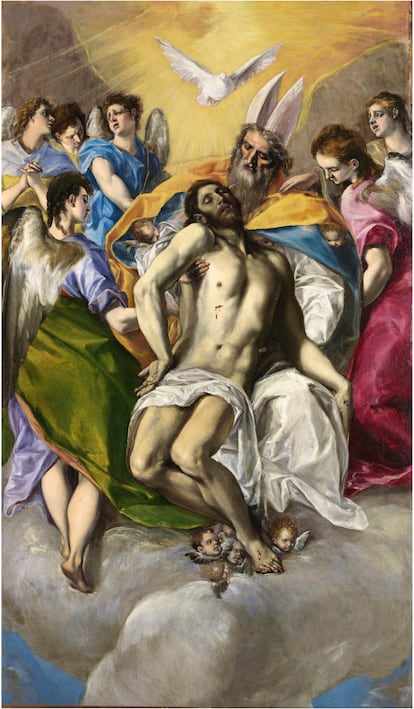
Following their completion in 1579, the pieces began various trips around the world from 1830 onwards. During that time period, as Ruiz emphasizes, “a significant part of what was recognized in the 18th and 19th centuries as [belonging to] the great El Greco was substantiated.” Therefore, his pieces began to acquire significant value. In August of that year, Prince Sebastian Gabriel de Borbón acquired The Assumption of the Virgin for 14,000 silver coins. In 1868, the painting was transferred, along with the rest of his collection, to Pau, a town in the French Pyrenees. Following the prince’s death, the artworks were divided among his heirs. And, in 1902, for the first time, the Prado Museum held its first exhibition dedicated to El Greco.
In 1904, The Assumption of the Virgin was sold again, at the Durand-Ruel Gallery in Paris. Then, two years later, it was bought by Nancy Atwood Sprague, who donated it to the Art Institute of Chicago, where it remains. However, it has temporarily departed, thanks to a gentlemen’s agreement between Miguel Falomir, director of the Prado Museum, and the head of this American institution. This took place back in 2020, when the Spanish museum loaned works for a major El Greco exhibition, in exchange for one day having The Assumption back in its galleries.
More than 120 years had to pass before the piece traveled by plane to Madrid. And, due to its massive size, it made the journey separated from its frame, which arrived via another courier.
Both The Holy Trinity and Saint Benedict, after several journeys and confiscations, have also returned to the Prado. Saint Bernard ended up in the Hermitage Museum in Moscow, from where it hasn’t been able to travel. In 1964, The Holy Face of Jesus was removed from its altar and sold to a private collection. The Adoration of the Shepherds was in the Botín Foundation Collection, in northern Spain. And the other works were in the Monastery of Santo Domingo, where a delegation from the Prado Museum went to convince the nuns ― using cunning and patience ― to lend them the paintings.
“It was difficult,” Ruiz confesses. “[The Monastery] also lives off the visits [from art lovers] and from the delicious marzipans that they [sell].” In exchange, in addition to buying the sweets and inviting others to do so, the museum has agreed to restore one of the church’s pieces by the painter Eugenio Cajés.
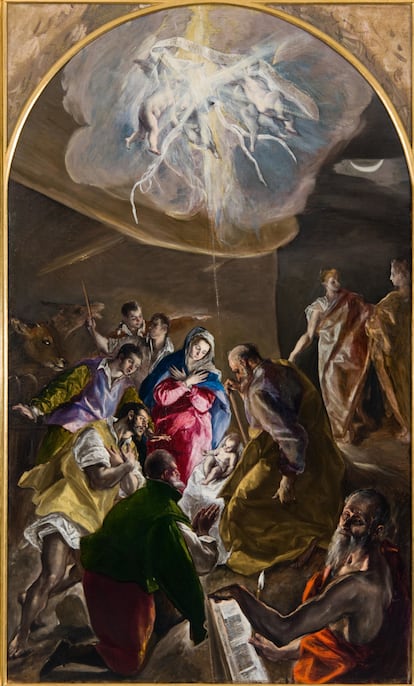
This small exhibition, made up of nine large works in total, ends with another painting from the Prado collection that serves as a closing piece. It’s also an invitation to enter the adjacent room that’s always dedicated to El Greco. The final painting is another version of The Adoration of the Shepherds, in which the artist portrays himself as a shepherd, kneeling before the child (Baby Jesus).
While standing in front of the canvas, Ruiz says that, up to this point in El Greco’s career, “it was evident how he took advantage of the layers of color with high-quality pigments.” From that moment on, you only have to turn your head and observe how “he begins to ignore the rules of Italian Renaissance painting: his canvases become narrower, he ignores conventional space and his figures become longer and are almost ethereal.”
There’s a 20-year difference between one painting and the other. There are two painters: the great Greco who landed in Spain and the other who, after a time spent in this new territory, became a major influence for the painters who led the trends of the 19th and 20th centuries, such as Picasso.
Sign up for our weekly newsletter to get more English-language news coverage from EL PAÍS USA Edition
Tu suscripción se está usando en otro dispositivo
¿Quieres añadir otro usuario a tu suscripción?
Si continúas leyendo en este dispositivo, no se podrá leer en el otro.
FlechaTu suscripción se está usando en otro dispositivo y solo puedes acceder a EL PAÍS desde un dispositivo a la vez.
Si quieres compartir tu cuenta, cambia tu suscripción a la modalidad Premium, así podrás añadir otro usuario. Cada uno accederá con su propia cuenta de email, lo que os permitirá personalizar vuestra experiencia en EL PAÍS.
¿Tienes una suscripción de empresa? Accede aquí para contratar más cuentas.
En el caso de no saber quién está usando tu cuenta, te recomendamos cambiar tu contraseña aquí.
Si decides continuar compartiendo tu cuenta, este mensaje se mostrará en tu dispositivo y en el de la otra persona que está usando tu cuenta de forma indefinida, afectando a tu experiencia de lectura. Puedes consultar aquí los términos y condiciones de la suscripción digital.
More information
Archived In
Últimas noticias
All the effects of gentrification in one corner of Mexico’s Colonia Roma
Palestinian reporter Youmna El Sayed: ‘My family told me I had to choose between being a journalist or a mother’
The new language of the workplace: Knowing how to ask AI questions is more important than using it
Russell Tovey: ‘I was advised many times not to come out, I don’t think there was many people who’d done that — and I feel really proud that I’m one of those that did’
Most viewed
- Christian Louboutin: ‘Young people don’t want to be like their parents. And if their parents wear sneakers, they’re going to look for something else’
- The low-cost creative revolution: How technology is making art accessible to everyone
- US sanctions against jailed cartel leader ‘El Marro’ highlight Mexico’s lack of control over its prisons
- Liset Menéndez de la Prida, neuroscientist: ‘It’s not normal to constantly seek pleasure; it’s important to be bored, to be calm’
- Cartels in Mexico take a leap forward with narco-drones: ‘It is criminal groups that are leading the innovation race’


